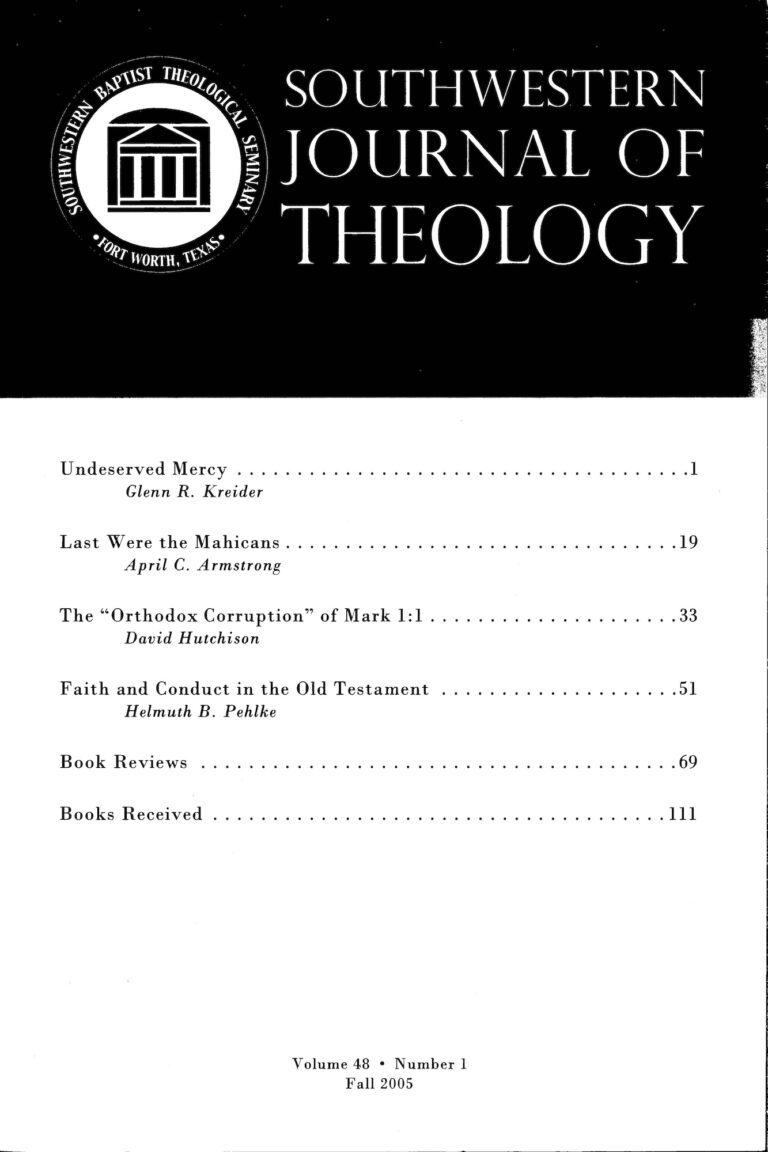
Southwestern Journal of Theology (48.1)
Southwestern Journal of Theology
Volume 48, No. 1 - Fall 2005
Editor: Paige Patterson
By John K. Tarwater. Lanham: University Press of America, 2006.136 pages. Softcover, $26.95.
There is no disputing the fact that marriage is in the midst of crisis. Christian and non-Christian alike are affected by its decline. John Tarwater attempts to build up the institution of marriage by showing it to be a binding and God ordained covenant. His perspective displays a high view of marriage and scripture. Tarwater begins by seeking the guidelines for covenant in scripture and then looks to it to examine whether marriage should be considered a covenant. Various models for marriage are examined with final emphasis given to Gordon Hugenberger’s Biblical-Concept Approach which is scholastically sound, based on scripture, and effective in dealing with modern hermeneutic concerns.
In a clear and systematic way, Tarwater identifies the essential elements of covenant and relates them specifically to marriage. Key verses throughout the Old and New Testaments are studied, and compared with related verses and concepts in order to delineate real meaning and application. This is the strength of the work, showing the continuity of scripture and the compatibility of regulations described therein. The author is thorough in his examination of the creation account and the establishment of marriage as a covenant in these initial verses. He sees the issues surrounding his topic clearly and applies them to the various issues of the day, such as homosexuality, divorce, and gender roles. While basing his conclusions on scripture, he is eager to address modern concerns the crisis of marriage is causing in the American church and U.S. civil law.
Tarwater binds himself to scripture and literally applies his conclusions. The high divorce rate shows that marriage as covenant is not the perspective of a large portion of the population. The book is a clear teaching tool defining covenant and showing how and why marriage should be viewed in this way. He explains that if marriage is proven to be a covenant, modeled after God’s definition in scripture and His relationship with His people, divorce is not an option. In order to prove this position, he addresses the various scriptures in the Old and New Testaments which seem to make allowance for divorce and explains his view of why these verses are often misunderstood and should not be applied in this manner.
While Tarwater is thorough, understands the issues, and makes clear application, he fails to answer some key questions raised by his conclusions. For example, he contends that covenants are accompanied by a sign, which in the case of marriage would be sexual consummation. Believing that the sign of the marriage covenant is sexual consummation, and there is no exception for divorce, the question of sexual promiscuity begs to be answered. Can the promiscuous person have covenants with many partners? Tarwater rightly explains that marriage is not simply a civil affirmation, but a covenant before God with responsibility and consequences. Marriage is a covenant ordained by God, but how does the free will of man fit into this picture? When a marriage covenant is established through sexual union that does not fit biblical guidelines of equally yoked believers, how is the issue of covenant to be understood? While Tarwater takes great care to answer many questions of interest, he leaves others unanswered, notably on remarriage, divorce when unbelieving spouses choose to leave, unwed mothers, abusive relationships, and consequences for the breaking of the covenant.
Instead, Tarwater takes time to discuss the order of marriage as described through gender issues of role assignment and equality in marriage. He understands and explains some of the debate between egalitarians and complementarians and draws the correct conclusion that this evangelical debate is tied to the creation account and covenant marriage. While there is a strong link and real interest in the topic, he might have dealt more thoroughly with the further implications of marriage and divorce before moving on to these issues.





